By Mike Darwin
“Possibly the most important discovery we have made about ourselves is that Man is a Wild Animal. He cannot be tamed and remain man: his genius is bound up in the very qualities that make him wild…Not even the H-bomb could change our inner nature. We have learned most bloodily that the H-bomb does nothing that the stone axe did not do – and neither weapon could tame us. Man can be chained, but he cannot be domesticated, and eventually he always breaks his chains.
Robert A. Heinlein, “The Third Millennium Opens,” 1956.
What was the physical state affairs at the ICBM installations in the USSR at the time the arms race began and the much touted Missile Gap was announced to American public and to the US’ allies in NATO? I know of no open sources of photo-documentation of the four ICBM sites that existed in the USSR at that time. One of them was Baikinour, located in the desert on the frigid steppes of Kazakhstan. With the dawn of the “space age,” with the launch of Sputnik I in October of 1957, it became the Baikinour Cosmodrome. The other sites are not available for “authorized” public inspection; they are falling to ruin and far too dangerous for tourists clamber around in. However, they are fair game for the Urban Explorer and one such site has been photographed (see Figures 44-50, below).
The Pervomaysk site itself dates back to ~1962, and the exterior facade to that facility is visible, and it is singularly unimpressive. It might even be said it is quite sad when compared to the Titan I sites that were blossoming in the US at the same time.
 Figure 40: The Soviet “equivalent” of the Titan 1 Missile Site in Pervomaysk, Ukraine. This site was active in 1961 and was one of the first operational ICBM sites.
Figure 40: The Soviet “equivalent” of the Titan 1 Missile Site in Pervomaysk, Ukraine. This site was active in 1961 and was one of the first operational ICBM sites.
The Soviet R-7/SS-6 Sapwood missile was certainly impressive in it’s range of ~ 8,000 km and its throw weight of 3000 kg. Because Soviet thermonuclear weapons were heavier and bulkier than their US counterparts, the Russians were forced to design and build boosters with heavy lift capacity. Additionally, because the state-of-art electronics and the variety of off the shelf components were much more limited in the USSR than in the US, the R-7 missiles had to be engineered with simplicity, ruggedness and reliability in mind. The relative lack of GDP of the USSR, when compared to the US, also meant that the systems being built had to serve their purpose over a prolonged period of time; rapid obsolescence and the associated high costs were simply not an option.
 Figure 41: The comparative bulk and weight of Soviet thermonuclear weapons (as contrasted with those of the US at the time) necessitated the construction of heavy lift boosters with a high specific impulse of thrust. This positioned them perfectly for launching small payloads into stable earth orbit and for launching heavier payloads, such as manned spacecraft, into low earth orbit. All heavy life boosters currently operating are lineal descendants of the SS-6 ICBM.
Figure 41: The comparative bulk and weight of Soviet thermonuclear weapons (as contrasted with those of the US at the time) necessitated the construction of heavy lift boosters with a high specific impulse of thrust. This positioned them perfectly for launching small payloads into stable earth orbit and for launching heavier payloads, such as manned spacecraft, into low earth orbit. All heavy life boosters currently operating are lineal descendants of the SS-6 ICBM.
The legacy of that design envelope is still being enjoyed today, not only by the Russians, but by the world. The basic platform of the SS series went on to become the Vokstok and it is the descendants of the Vokstok that today are the only truly heavy lift boosters humanity has for accessing space. These spacecraft are the largely unnoticed and unremarked upon workhorses that routinely complete their duties carrying both men and materiel to the International Space Station.
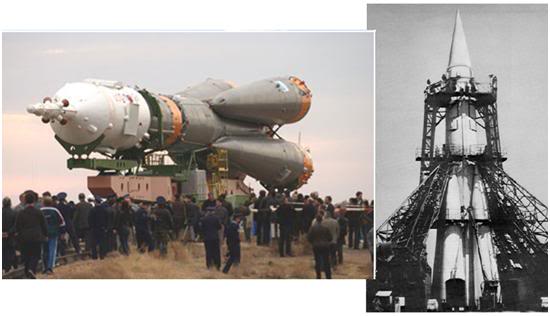
Figure 43: Two views of the SS-6: at left, the rocket is shown in its horizontal configuration for transport to the launch site. At right, the rocket is shown ensconced in its launch gantry. The SS-6 employed kerosene and liquid oxygen as its propellants. This combination provides a high specific impulse providing the rocket with maximum fuel efficiency.
Some idea of what the Russian equivalent of the Titan 1 ICBM facilities looked like can be gleaned from photos taken in one of the abandoned (gutted) facilities that were documented by Urban Explorers after the collapse of the Soviet Union. As can be seen from the photos below, they were a small fraction of the size of US installations and were constructed at a small fraction of the costs.
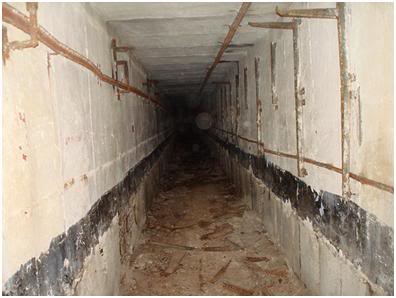
Figure 44: Access tunnel leading to the operations and engineering centers of a 1960s era Soviet SS-6 ICBM site. The brackets on the right originally supported electrical cables.

Figure 45: Blast door protecting the personnel entrance into the engineering center.
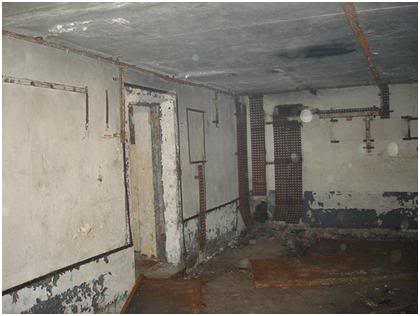 Figure 46: Launch control room.
Figure 46: Launch control room.
Figure 47: Engineering room.
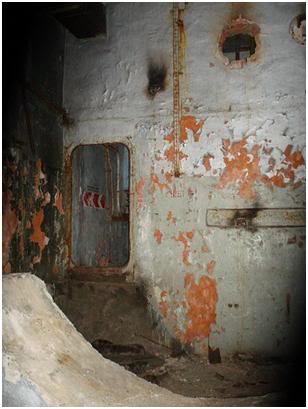 Figure 50: Propellant storage room.
Figure 50: Propellant storage room.
The R-7 was stored horizontally in earth sheltered bunkers. To be readied for launch, the missile was removed from the bunker, erected upright in a complex steel truss assembly (Figure 43), and then fueled for launch with kerosene and LOX. Sergei Korolev, the chief designer of the R-7, made a number of fundamental design improvements over his Nazi predecessors’ V-2. He abandoned exhaust jet vanes for control (which decreased thrust and were difficult to engineer reliably) and instead employed dedicated control engines mounted near the top of the rocket.. The control engines also served as the last stage’s vernier thrusters, thus adding greater precision to targeting. Korolev also abandoned the launch pad system and instead, suspended the rocket in a web-work of steel trusses that bore the vertical weight load, and served to protect the rocket against horizontal wind forces.
As previously noted, the process of preparing the-7 for launch took hours and each of the four R-7s could deliver only one nuclear weapon of comparatively low mega-tonnage. In other words, the whole arms race began over pathetically little, and escalated largely on the basis of very serious fears on the part of the Soviets that US was preparing for a first strike, and that the massive construction boom of US nuclear missile sites, at the cost of billions of US dollars, was proof positive of these intentions.
Similarly, in the US, there was deep mistrust of the USSR, particularly as a result of posturing and because of the long stated intention of the USSR to expand its sphere of influence wherever, whenever possible, including by the use of military action. Lack of information due to state imposed secrecy on both sides, coupled with the personal angst and enmity that the leaders of the two empires felt towards their opposite nation state, ensured that the escalation would continue unabated. A much better understanding of the Soviet mindset can be had by reading the extraordinary collection of documents in “John Hines’ Report- Soviet Intentions, 1965-1985” (see the Special Bibliography at the end of this article). The inescapable conclusion is that Soviet arms proliferation was driven primarily by a fear of a US first strike.
As the arms race escalated throughout the 1970s and into the 1980s and 1990s, the USSR developed a “lower” technology, less expensive, but still very lethal land-based nuclear delivery platform. It was that technology that I went to Pervomaysk to explore.
 Figure 51: Layout of a typical Soviet ICBM site in the 1980s and 1990s. A lower security area of the base fronted the access road and consisted of first tier security facilities, vehicle bays, barracks and infrastructure for base security and support personnel. In back of this area was the high security zone enclosing the missile and associated launch infrastructure. This consisted of housing for the officers and political apparatchiks (D), the underground launch command/control center (A), the R-36 missile silo (B), a hardened security bunker (C) and a surface engineering and power generating plant.
Figure 51: Layout of a typical Soviet ICBM site in the 1980s and 1990s. A lower security area of the base fronted the access road and consisted of first tier security facilities, vehicle bays, barracks and infrastructure for base security and support personnel. In back of this area was the high security zone enclosing the missile and associated launch infrastructure. This consisted of housing for the officers and political apparatchiks (D), the underground launch command/control center (A), the R-36 missile silo (B), a hardened security bunker (C) and a surface engineering and power generating plant.
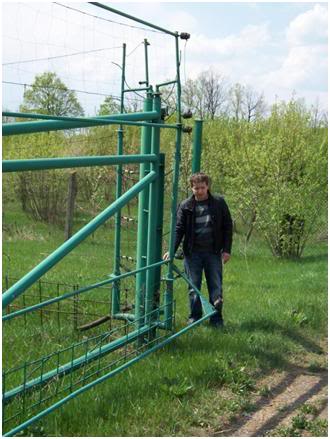 Figure 52: Inner perimeter high tension electric fence. This fence was not present as just as a deterrent; contact with it would have been immediately lethal.
Figure 52: Inner perimeter high tension electric fence. This fence was not present as just as a deterrent; contact with it would have been immediately lethal.
The basic layout of a Soviet ICBM site as it was configured in the 1980s is shown in Figure 51, above. These sites maintained a significant contingent of regular army and their command personnel present on the site. The Pervomaysk site was under the command of the 46th Missile Division of the 43rd Rocket Army. This site was occupied since ~1960 and housed successive generations of SS-series ICBMs beginning with the SS-4 through to the SS-24 in 1996.
Security consisted of multiple perimeters, beginning with a barbed wire fence and guard shack with a standoff area that was patrolled by armed troops. Inside that perimeter was a triple layer of fences; another barbed wire fence in close juxtaposition to high tension electrical fence, followed by another barbed wire fence, the latter of which enclosed the whole of the actual missile launch complex itself. The road access guard shack was supplemented by a hardened, machine gun equipped bunker on the campus of the missile site itself which is labeled “C” in Figure 51, above. Housing for the command and control crew was also placed inside the innermost perimeter (D). Guard dogs were also present and allowed to move freely within the innermost perimeter. It was interesting to note that poison ivy had once been planted along the length of the inner perimeter high tension electrical fence – there are still some healthy specimens, of nearly man-height, growing there today.
 Figure 53: The control center was a modular 12-storey facility that was trucked to and from the site for deployment and refurbishment. The control center was shock mounted to withstand a direct nuclear hit with a low mega-tonnage weapon such as the US used at that time. The control center housed the launch control facilities, communications, crew housing and basic life support infrastructure sufficient to permit the survival of 3 men for 45 days.
Figure 53: The control center was a modular 12-storey facility that was trucked to and from the site for deployment and refurbishment. The control center was shock mounted to withstand a direct nuclear hit with a low mega-tonnage weapon such as the US used at that time. The control center housed the launch control facilities, communications, crew housing and basic life support infrastructure sufficient to permit the survival of 3 men for 45 days.
 Figure 54: At left, one of the specialized vehicles used to raise and lower the command center from its concrete bunker. The circular structure to the right of the vehicle is the top of the command silo, which would be removed to allow the command center to be removed or emplaced.
Figure 54: At left, one of the specialized vehicles used to raise and lower the command center from its concrete bunker. The circular structure to the right of the vehicle is the top of the command silo, which would be removed to allow the command center to be removed or emplaced.
Lacking the enormous capital of the US to expend on ICBM sites, the Soviets engineered against obsolescence. One of their cleverest maneuvers was to configure the subterranean command and control facilities in a modular way so that the entire facility could be “pulled and replaced” using specialized trucks. Communications, ancillary electronics, crew housing, basic life support equipment, and the command and launch control facilities were configured into a “subterranean submarine” that could be lowered into or removed from a hardened, steel reinforced concrete silo (Figures 53 & 54).
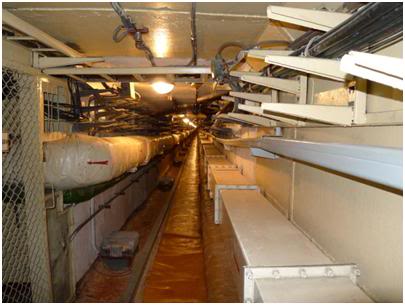 Figure 55: Underground access tunnel connecting the above ground facilities and engineering bunker to the command center.
Figure 55: Underground access tunnel connecting the above ground facilities and engineering bunker to the command center.
This facility was accessed by a series of underground tunnels, at least one of which connected it with topside underground bunkers containing power generating, water pumping, heating, cooling and air handling equipment for routine, day-to-day operations. Water was supplied by an on-site well. While these facilities were located below ground and were hardened, it seemed unlikely that they could withstand a direct hit. There was no spring/cantilever mounting of the industrial infrastructure and the blast protection also appeared to be inadequate to withstand a direct hit with a nuclear weapon.
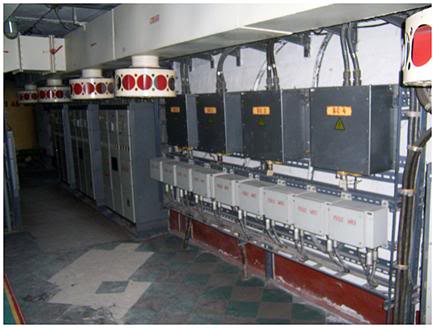 Figure 56: Electrical distribution center in engineering bunker at the R-36 site in Pervomaysk. This bunker was located approximately 4 meters underground adjacent to the missile command center.
Figure 56: Electrical distribution center in engineering bunker at the R-36 site in Pervomaysk. This bunker was located approximately 4 meters underground adjacent to the missile command center.
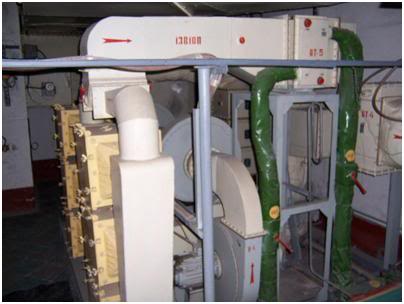 Figure 57: Some of the air handling equipment supporting the control center located in the engineering bunker.
Figure 57: Some of the air handling equipment supporting the control center located in the engineering bunker.
When I inquired about this, I encountered a raised eyebrow and a sly smile. This problem had been overcome by the expedient of installing a below ground ~120,000 liter insulated water tank which was filled water refrigerated to well below 0○C. In other words, there were 264,000 kilgrams of ice stored underground. In the event that the high capacity generating and cooling facilities were destroyed in a first strike, the crew and the site could continue to operate for ~45 days with more conpact and less sophiosticated power generation facilities contained within the command and control structure. The massive and complex infrastructure required to provide cooling and power could thus be sacrificed if need be, eliminating the need for the vast concrete domes and associated engineering works that dominated much of the Titan I and Titan II sites.
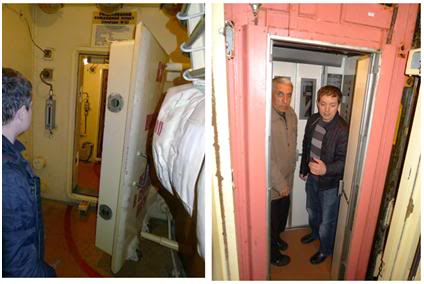 Figure 58: At left, primary personnel entry blast door which protects the control center silo contents. At right, just beyond the blast door is a 3-3 man elevator that provided routine acess to the control center.
Figure 58: At left, primary personnel entry blast door which protects the control center silo contents. At right, just beyond the blast door is a 3-3 man elevator that provided routine acess to the control center.
Personnel access to the command and control “submarine” was via a heavy blast door which protected the inteerior of the concrete silo and a small 2-man personnel elevator that provides access to the structure. Again, modularizing this element of the site meant that there was no need for massive infrastructure to move equipment in and out of the facility for updating or servicing.
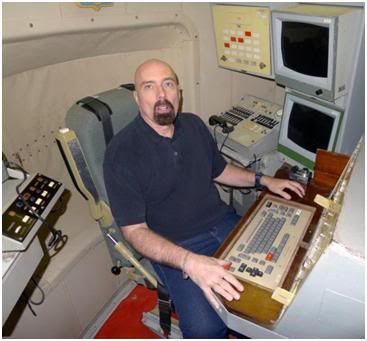 Figure 59: The author, sitting in the commander’s chair at the R-36 launch control panel. The Soviet’s used a two key system that operated on the same principle as that employed in US ICBM installations. Each officer had a key and both keys and accompaning codes were required to be used before launch could take place. The officers staffing the control center were stationed at two launch control consoles sufficiently far apart that both men would have to be present and functioning in order to initiate a launch. Unless, of course, there was an override from the Kremlin.
Figure 59: The author, sitting in the commander’s chair at the R-36 launch control panel. The Soviet’s used a two key system that operated on the same principle as that employed in US ICBM installations. Each officer had a key and both keys and accompaning codes were required to be used before launch could take place. The officers staffing the control center were stationed at two launch control consoles sufficiently far apart that both men would have to be present and functioning in order to initiate a launch. Unless, of course, there was an override from the Kremlin.
One of the costs of this trade-off was that the crew quarters and the launch control facilities were small – submarine small – as can be seen by examinig the wall radius in Figures 59 & 60. Functional areas were stacked atop each other with the launch control room sitting atop the crew quarters at the very bottom (and thus most protected) part of the structure. Since the top of the structure had to be accessible for removal of the command/control module, it could not be earth sheltered from radiation. Thus, much of the shielding was supplied by the structure itself.

Figure 60: The author, descending from the launch control room to the crew quarters in the control center. The crew quarters were very small and were not used for routine, day-in , day-out housing; off duty launch control officers were quarted in above ground structures on the base.
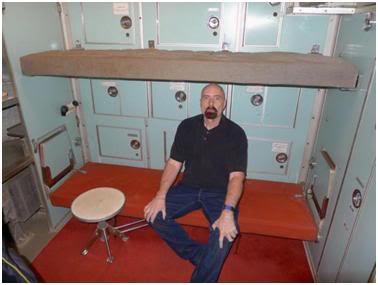
Figure 61: The crew quarters were capable of housing 3 men for a period of up to 45 days. Launch control officers spent only brief periods of time resting in these quarters during a normal 9 hour shift.

Figure 62: Sanitary facilities in the command center. The sense of the place was very much like that of being in a submarine or a spacecraft.

Figure 63: R-36/SS-18 Satan ICBM decomissioned and cut open for viewing.
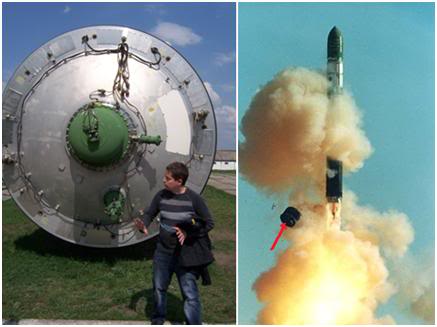
Figure 64: At left above, our guide explains that the “cap” covering the combustion chambers of the R-36 is an explosive device designed to boost the missile clear of the silo before rocket engine ignition. At right, the “boost cap” (red arrow) can be seen falling away from an R-36 immediately after engine ingnition.
The Pervomaysk sites were home to a variety of ICBMs over the years, the last and most impressive of which was the R-36/SS-18 “Satan.” If the USSR achieved effective first strike capability it was with the R-36. The Satan was comprised of a first stage with a 460,000 kgf (4.5 MN) thrust motor with four combustion chambers and exhaust nozzles, and a second stage consisting of a single-chamber 77,000 kgf (755 kN) thrust motor giving the Satan a throw weight of 8,800 kg. This made the R-36 the world’s heaviest ICBM; by comparison, the heaviest US ICBM (the now retired LGM-118, Peacekeeper) had less than a half the Satan’s throw weight (4,000 kg). The first generation R-36 carried a single warhead of up to 20 mt and the R-36M, the most deployed configuration, carried ten MIRV ~600 k KT yield warheads that were deployed with and up to 40 penetration aids.
A number of intelligence analysts believed that this capability was sufficient to destroy most of the US’ LGM-30 Minuteman ICBM silos and their launch control centers before retaliation was possible. By 1979 a number of the R-36 sites had been outfitted with with a single reentry vehicle carrying an 18-25 MT warhead (SS-18 Mod 3). The high yield of these warheads is generally believed sufficient to have destroyed the heavily hardened US Minuteman III sites. The deployment of the R-36M (there were 308 of them in place by the mid-1980s), was a major factor in motivating US President Ronald Reagan to initiate his fanciful Strategic Defense Initiative (SDI) program, dubbed “Star Wars.” The ostensible goal of SDI was the deployment of a land and space-based anti-missile system that would have used lasers to intercept hostile incoming ICBMs during every phase of their post launch flight. In one of the most remarkable bluffs of the Cold War, Reagan managed to cause sufficient suspension of disbelief to allow this then technologically impractical (if not impossible) program to be taken seriously and to influence Soviet arms policy.
Unlike the R-7, the Satan used unsymmetrical dimethylhydrazine (UDHD) as one of its bipropellants, however, nitrogen tetroxide replaced LOX as the oxidizer. The use of nitrogen tetroxide eliminated the large industrial infrastructure required to produce liquid air and separate the LOX. Since LOX comprises only ~21% of liquified air, the liquefaction process is not only energy intensive, it very inefficient. Eliminating LOX as the oxidizer also abolished the need for the substantial cryogenic infrastructure required to store it.
I do not know if US ICBM sites had (or have) a similar mechanism in place, but the device in Figure 64, below, is one of several “remote launch” antennaes on the site. The Soviets provisioned all their ground based ICBM sites with the capability to be remotely launched by the Kremlin without need for the assent or cooperation of the on site personnel. As I stood there on that sunny, beautiful day and contemplated the remote launch antenna (there was at least one more, adjacent to the missile silo) the old Russian proverb, oft used by Comrade Lenen, “Доверяй, но проверяй,”came to mind. As the former launch control officer who served as our guide wryly noted, “Anywhere you are on the site, if you can see one of the remote launch antennae, then you know in which direction Moscow lies.”
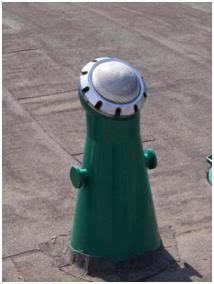 Figure 65: One of the remote launch antennae pointed towards Moscow.
Figure 65: One of the remote launch antennae pointed towards Moscow.
The interior of the missile silo was also contructed so that it could accept any of a variety of the Satan series ICBMs. All missiles in this series used an explosive charge to boost the missile clear of the silo prior to engine ignition (Figure 64). This greatly simplified silo design, elimnated the need for complex and costly elevators, and allowed for the silo to be reused, should the need arise, post Armageddon.
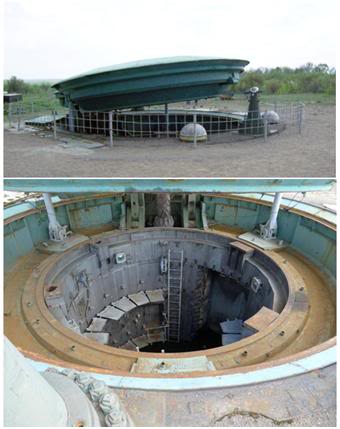 Figure 65: Top: Blast hardened cover to the R-36 silo. Bottom: A peek inside an R-36 missile silo. Decomissioned silos were filled with concrete and there is standing rainwater barely visible towards the bottom center of the photo above. The uptilting metal plates present in two tiers adjacent to the ladder were work platforms to allow technicians to service themissile in situ.
Figure 65: Top: Blast hardened cover to the R-36 silo. Bottom: A peek inside an R-36 missile silo. Decomissioned silos were filled with concrete and there is standing rainwater barely visible towards the bottom center of the photo above. The uptilting metal plates present in two tiers adjacent to the ladder were work platforms to allow technicians to service themissile in situ.
Perversion of a Noble Goal
The men who ordered these astonishing feats of doomsday engineering built are as old and as common as Caesar, Atilla, Napoleon or the local bully or gangster. They are as old as mankind, in fact, far older, and it is that reality, the reality that the elements in us which empower violence, the the threat of violence and ultimately war on a planet-wide scale often without reason or justification, predate humanity. As Heinlein says in the quote that opens this piece, “man can be chained, but he cannot be domesticated.” This, I think, is likely the truth – a reality built into our biology. No easy solution to this problem exists, or seems likely to. As cryonicists we must proceed accordingly. We must be aware that it is very likely that only the most carefully contemplated and executed changes to our fundamental neurobiology will restrain the behaviors and the paranoid mental states that underlie them. Those changes may well be unpopular; may in fact lead to the fragmentation of our species. From our poor vantage point today, it is impossible to know what the outcome will be – or even if any fundamental re-engineering of man will be attempted. We can only speculate, try to gauge the threats to our existence in the meanwhile, and act accordingly.
End of Part 4
Special Bibliography
John Hines’ Report- Soviet Intentions, 1965-1985
Document 1: Memo for Distribution by Andrew W. Marshall, director of Net Assessment, Office of Secretary of Defense, “John Hines’ Report- Soviet Intentions, 1965-1985,” 22 September 1995
In this memorandum, Marshall wrote that study director John Hines left BDM before finishing the report and that he (Marshall) was not entirely satisfied with the findings. Marshall did not specify which aspect of the report was incomplete, but it is evident that that he was not persuaded by the argument about the role of the defense industrial complex in establishing force levels.
Document 2:
Soviet Intentions 1965-1985, Volume I: An Analytical Comparison of U.S.-Soviet Assessments During the Cold War by John Hines, Ellis M. Mishulovich, and John F. Shulle
BDM Federal, Inc., September 22, 1995, Unclassified, excised copy.
Front Matter: Acknowledgements, Introduction/Preface, The Research Process-Debriefing Unhappy Cold Warriors … i-vi
Chapter I Macro Trends in Soviet Strategy 1965 –1985 … 1-8
Chapter II Soviet View of the Strategic Relationship … 9-21
Parity … 9
Deterrence … 13
Chapter III. Evolution of Soviet Strategy … 22-47
Utility of Nuclear Weapons … 22
Outcome of Nuclear War … 25
Preemption … 27
Limited Nuclear Options … 35
Escalation … 40
Chapter IV Factors in Soviet Force Building and Strategic Decision Making … 48-67
Ineffectual Leadership at the Top … 50
Struggles Among the Princes … 52
Rule of the Industrialists … 59
Strategic Consequences … 65
Chapter V Conclusions, with Appendix A: A Chronology of Soviet Strategy and Bibliography … 68-77
Soviet Intentions 1965-1985 Volume II: Soviet Post-Cold War Testimonial Evidence, Unclassified, excised copy.
Front Matter: Comments on Interview Process and Table of Contents … i
Marshal Sergei F. Akhromeev, Advisor to the President of the USSR … 3-6
Gen.-Lt. Gelii Viktorovich Batenin, First Deputy Chief of the General Staff … 7-10
Sergei Blagovolin, Head of Department for Military-Economic and Military-Political Research, Institute of the World Economy and International Relations (IMEMO) …. 11-12
Harold Brown, Secretary of Defense … 13-15
Zbigniew Brzezinski, Assistant to the President for National Security Affairs … 16-17
Dmitrii S. Chereshkin, Head of a Department in the All-Union Scientific-Research Institute for Systems Studies (VNIISI) … 18
Gen.-Col. (Ret.) Adrian A. Danilevich, Special Advisor for military doctrine to the Chief of the General Staff … 19-71
Gen. Makhmut A. Gareev, Special Representative of the Soviet Ministry of Defense in Afghanistan …72-76
Fred C. Iklé, Under Secretary of Defense for Policy… 77-78
Gen.-Col. Igor’ V. Illarionov, Assistant to Ustinov for special assignments …79-85
A. S. Kalashnikov, Chairman of the State Commission on Nuclear Testing at Semipalatinsk … 86-95
Vitalii Leonidovich Kataev, Senior Advisor to the Chairman of the Defense Industrial Department of the Communist Party Central Committee … 96-101
Gen.-Maj. (Ret.) Iurii A. Kirshin, Deputy Director, Institute of Military History… 102-104
Robert W. Komer, Under Secretary of Defense for Policy … 105
Gen.-Col. (Ret.) Varfolomei Vladimirovich Korobushin, Director of the General Staff’s Center For Operational and Strategic Research (TsOSI) … 106-108
Gen.-Lt. (Ret.) Nikolai Vasil’evich Kravets, SRF officer … 109-110
Gen.-Col. Gegorii Fedorovich Krivosheev, Deputy Chief of the General Staff, Chief of the Main Directorate for Organization and Mobilization … 111-114
Colonel Petr M. Lapunov, director of department for force analysis, TsOSI General Staff … 115-117
Andrew W. Marshall, Director, OSD Net Assessment … 118-119
Rod McDaniel, NSC Staffer … 120-121
Iu. A. Mozzhorin, General Director of TsNIIMash, the main research and design institute of the Ministry of General Machine Building (MOM) … 122-126
Vladimir Rubanov, former official in the Soviet Ministry of Aviation … 127
James R. Schlesinger, Secretary of Defense … 128-130
Vitalii V. Shlykov, Deputy Chairman, Russian Soviet Federated Socialist Republic State Committee on Defense … 131
Boris Aleksandrovich Strogonov, Defense Industrial Department of Central Committee … 132
Viktor M. Surikov, President of the Institute for Defense Studies (INOBIS) … 134-135
Dr. Vitalii Nikolaevich Tsygichko, Senior Analyst at VNIISI … 136-157
Gen.-Col. Dmitrii Volkogonov, Director, Institute of Military History … 158
APPENDIX A: Partial List of Decision Makers and Analysts … 159-160
APPENDIX B: Research Questions for Soviet Interview Respondents … 161-164
APPENDIX C: Research Questions for U.S. Interview Respondents … 165
APPENDIX D: List of Acronyms and Abbreviations … 166-167
APPENDIX E: Tsygichko’s Kommentarii k interv’iu v 1990-1991 godu … 168 [Detailed summary/translation prepared by Svetlana Savranskaya]
Index … 178
Document 3: SALT II and the Growth of Mistrust: Conference # 2 of the Carter-Brezhnev Project: A Conference of U.S. and Russian Policymakers and Scholars Held at Musgrove Plantation, St. Simons Island, Georgia 6-9 May 1994, Excerpt (May 7, Morning Session)
Document 4: Vitalii Nikolaevich Tsygichko, Models in the System of Military-Strategic Decision Making in the USSR (Moscow, 2005), with English-language summary prepared by Svetlana Savranskaya attached
Document 5: Jan Hoffenaar and Christopher Findlay, editors, Military Planning for European Theater Conflict during the Cold War: An Oral History Roundtable Stockholm, 24-25 April 2006 (Center for Security Studies, ETH Zurich, 2006)
